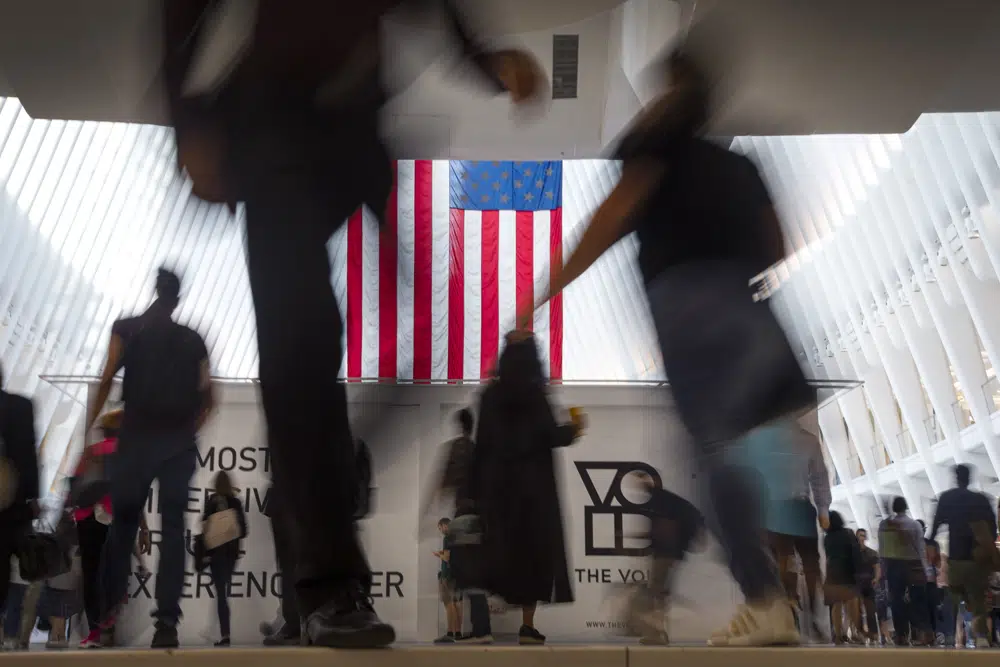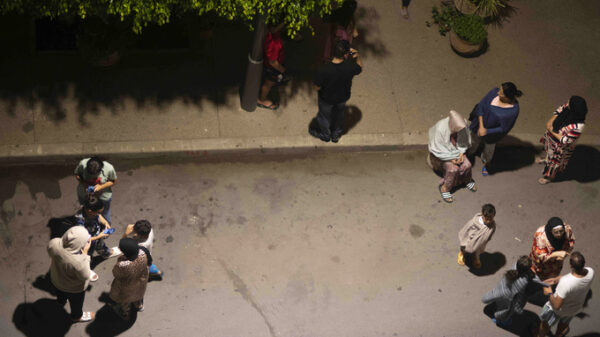FILE – People walk past an American flag inside the Oculus, part of the World Trade Center transportation hub, at the start of a work day in New York, Sept. 11, 2019. American lore is full of tales of a nation built on the foundations of individualism. In reality, loneliness in America can be deadly. In May 2023, the U.S. surgeon general declared it an epidemic, saying that it takes as deadly a toll as smoking. (AP Photo/Wong Maye-E, File)
NEW YORK (AP) — At the end of “The Searchers,” one of John Wayne’s most renowned Westerns, a kidnapped girl has been rescued and a family reunited. As the closing music swells, Wayne’s character looks around at his kin — people who have other people to lean on — and then walks off toward the dusty West Texas horizon, lonesome and alone.
It’s a classic example of a fundamental American tall tale — that of a nation built on notions of individualism, a male-dominated story filled with loners and “rugged individualists” who suck it up, do what needs to be done, ride off into the sunset and like it that way.
In reality, loneliness in America can be deadly. This month, U.S. Surgeon General Vivek Murthy declared it an American epidemic, saying that it takes as deadly a toll as smoking upon the population of the United States. “Millions of people in America are struggling in the shadows,” he said, “and that’s not right.”
He cited some potent forces: the gradual withering of longstanding institutions, decreased engagement with churches, the fraying bonds of extended families. When you add recent stressors — the rise of social media and virtual life, post-9/11 polarization and the way COVID-19 interrupted existence — the challenge becomes even more stark.
People are lonely the world over. But as far back as the early 19th century, when the word “loneliness” began to be used in its current context in American life, some were already asking the question: Do the contours of American society — that emphasis on individualism, that spreading out with impunity over a vast, sometimes outsized landscape — encourage isolation and alienation?
Or is that, like other chunks of the American story, a premise built on myths?
___
Alexis de Tocqueville, watching the country as an outsider while writing “Democracy in America” in the mid-1800s, wondered whether, “as social conditions become more equal,” Americans and people like them would be inclined to reject the trappings of deep community that had pervaded Old World aristocracies for centuries.
“They acquire the habit of always considering themselves as standing alone, and they are apt to imagine that their whole destiny is in their own hands,” he wrote. “Thus not only does democracy make every man forget his ancestors, but it … throws him back forever upon himself alone, and threatens in the end to confine him entirely within the solitude of his own heart.”This has been a recurring thread in how Americans perceive themselves. In the age before democracy, for better and for worse, “People weren’t lonely. They were tied up in a web of connections. And in many countries that’s more true than it was in the United States,” says Colin Woodard, director of the Nationhood Lab at the Pell Center for International Relations and Public Policy.
“There’s this idea that going out into those vast spaces and connecting with the wilderness and escaping the past was precisely what made us Americans,” Woodard says.
Yet many frontier myths skip over how important community has been in the settling and growth of the nation. Some of the biggest stories of cooperation — the rise of municipal organizations and trade unions, the New Deal programs that helped drag many Americans out of the Depression in the 1930s, war efforts from the Civil War to World War II — sometimes get lost in the fervor for character-driven stories of individualism.
Those omissions continue. Fueled in part by pandemic distrust, a latter-day strain of individual-over-community sentiment often paired with invocations of liberty and freedom occupies a significant chunk of the national conversation these days — to the point where advocacy about community thinking is sometimes met with accusations of socialism.
Let’s not consign Americans to be the heirs of a built-in loneliness gene, though. A new generation is insisting that mental health be part of the national conversation, and many voices — among them women and people of color — are increasingly offering new alternatives to the old myths.
What’s more, the very place where the discussion about loneliness is being held today — in the office of the surgeon general, a presidential appointee — suggests that other paths are possible.
The ways Americans perceive themselves as solitary (whether or not it’s true) can be seen in their art.
One of the nation’s early art movements, the mid-19th-century Hudson River School, made people tiny parts of outsized landscapes, implying both that the land dwarfed humans and that they were being summoned to tame it. From that, you can draw a line straight to Hollywood and director John Ford’s Westerns, which used vast landscapes to isolate and motivate humans for the purposes of telling big stories. Same with music, where both the blues and the “ high lonesome sound ” helped shape later genres.
In the suburbs, Betty Friedan’s groundbreaking “ The Feminine Mystique ” helped give voice to a generation of lonely women. In the city, Edward Hopper’s work — like the iconic ” Nighthawks ” — channeled urban loneliness. At around the same time, the emergence of film noir — crime and decay in the American city its frequent subject — helped shape the figure of the lonely man alone in a crowd who might be a protagonist, might be an antagonist, might be both.
Today, loneliness plays out on streaming TV all the time in the forms of shows like “Severance,” “Shrinking,” “Beef” and, most prominently, the earnest “Ted Lasso,” a show about an American in Britain who — despite being known and celebrated by many — is consistently and obviously lonely.
In March, the show’s creator and star, Jason Sudeikis, appeared with his cast at the White House to talk about the issue that the show is, in its final season, more about than ever: mental health. “We all know someone who has, or have been that someone ourselves actually, that’s struggled, that’s felt isolated, that’s felt anxious, that has felt alone,” Sudeikis said.
Solitude and isolation do not automatically equal loneliness. But they all live in the same part of town. During the pandemic, Murthy’s report found, people tightened their groups of friends and cut time spent with them. According to the report, Americans spent 20 minutes a day with friends in 2020 — down from an hour daily two decades ago. Granted, that was during peak COVID. The trend, though, is clear — particularly among young people ages 15 to 24.
Perhaps many Americans are alone in a crowd, awash in a sea of voices both physical and virtual yet by themselves much of the time, seeking community but suspicious of it. Some of the modernizing forces that stitched the United States together in the first place — commerce, communication, roads — are, in their current forms, part of what isolates people today. There’s a lot of space between the general store and Amazon deliveries to your door, between mailing a letter and navigating virtual worlds, between roads that connect towns and freeways that overrun them.
And if Americans can figure out more about what connects and what alienates, some answers to the loneliness epidemic might reveal themselves.
“We must, indeed, all hang together or, most assuredly, we shall all hang separately,” Benjamin Franklin, not incidentally the country’s first postmaster general, said under very different circumstances. Or perhaps it’s put better by the American poet Amanda Gorman, one of the country’s most insightful young voices. This is from her poem “ The Miracle of Morning,” written in 2020 during the early part of the pandemic.
“While we might feel small, separate, and all alone,
our people have never been more closely tethered.
Because the question isn’t if we can weather this unknown,
but how we will weather this unknown together.”
Copyright 2021 Associated Press. All rights reserved.
Source: https://apnews.com/article/loneliness-lonely-alone-surgeon-general-c44798ddbe95d9e3da1367cefd25ec93





























You must be logged in to post a comment Login